Good business to consumer marketing (B2C marketing) is the lifeblood of any consumer-facing business. Even Apple, the best-known and most valuable consumer electronics company in the world still invests heavily in B2C digital marketing and advertising.
Itís how you win customers in an incredibly competitive market, build loyalty among those customers, and encourage repeat purchases.
But what does B2C marketing mean, which channels should you use, and how can you improve your odds of your success? Iíll explain everything in this article. If youíre ready to start implementing B2C marketing ideas, then letís begin.
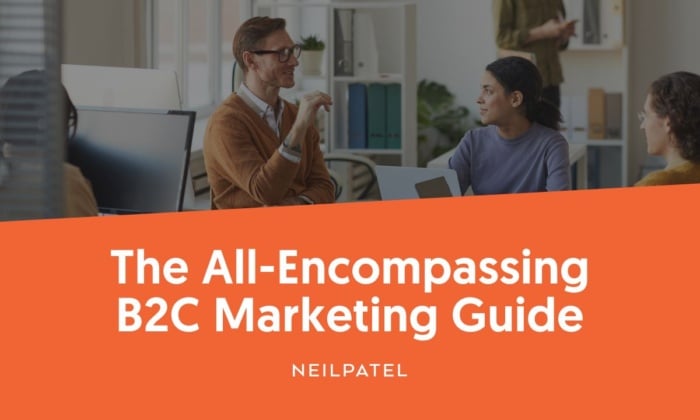 What Is B2C Marketing?
What Is B2C Marketing?B2C marketingóalso known as business-to-consumer marketing or just consumer marketingóis the process of selling to individual consumers (rather than other businesses).
A lot of people will tell you that the B2C marketing funnel is short. Customers are looking to fill an immediate need. They want a product and they do a Google search (or head to Amazon) to buy it. But I donít think thatís always true.
In many casesóand especially for expensive productsócustomers do a significant amount of research and comparison shopping. In other words, the customer journey can be very direct, but it can also be fairly convoluted and have a lot of different touch points.
Because of the proliferation of e-commerce, social media, and the internet in general, B2C marketing happens mostly online. But there are plenty of traditional, offline B2C marketing strategies you can use, too.
B2C vs. B2B MarketingUnlike B2C marketing, brands use B2B marketing to target other companies rather than individual consumers. But itís not just the target audience that is different between these two marketing strategies.
Here are some more ways B2B marketing is different from B2C marketing:
1. B2B sales cycles tend to be longer
2. B2B products tend to cost more
3. B2B marketers usually target a smaller audience
4. B2B buyers tend to do more research
5. B2B buyers typically have a strict approval process
6. Because of the longer and more complex buying process Iíve described above, many marketers will tell you B2C marketing is easier
than its B2B sibling. But I think thatís unfair. B2C marketing is often much more competitiveóand that can make it just as tough a
nut to crack.
B2C Marketing Facts and StatsWant to get the top line on the size and importance of the B2C space? Check out these facts:
The global B2C e-commerce market will be worth $6.5 trillion in 2023.
There are over 30,000 stores on Amazon in the U.S., selling over 2.5 million products.
The vast majority (80 percent) of marketers plan to keep the same B2C inbound marketing budget or add more for this strategy.
Build a Strong Foundation for B2C Marketing CampaignsHereís my four-step plan to get you started on the path of a killer marketing B2C campaign.
1. Define Your Brand IdentityThe B2C space is incredibly competitive. You need to have a strong brand identity to stand out from the crowd and get the attention of competitors.
Think about Oatly. There are dozens of milk alternatives, as well as specific oat-based drink brands, but Oatly has done a fantastic job of creating a bold brand identity. While only 31 percent of people say oat milk is their favorite non-dairy alternative, Oatly has 54 percent brand awareness across all U.S. consumers. It is thanks, in part, to ads like this:
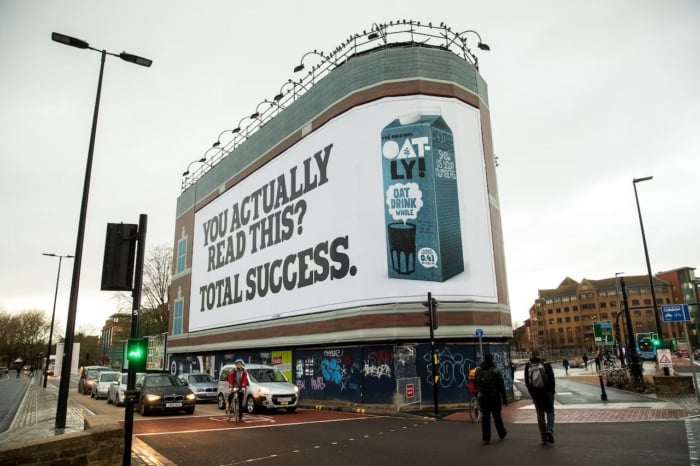
So, what does your brand stand for? How do you want to be seen?
Once youíve answered these questions, you can craft a consistent image and tone of voice and apply them to all of your B2C marketing efforts.
2. Develop Compelling Value PropositionsA value proposition is a statement that communicates the benefits you offer to customers and the things that make your brand stand apart.
Think of it like a 30-second elevator pitch. Whatís going to make customers choose your brand over your competitors?
3. Create Buyer PersonasWho are you targeting? Without a clearly defined target audience, it can be difficult to find the right B2C marketing channels and your campaigns can quickly lose money. Thatís where a buyer persona comes in.
A buyer persona is a detailed description of an imaginary member of your target audience. It includes demographic information, as well as their preferences, behaviors, and desires. The more detailed your buyer personas, the easier it will be to build B2C marketing strategies that target them.
4. Set Clear GoalsWhat do you want to achieve from your B2C marketing ideas?
Think about your overall business objectives, and then highlight one or more specific improvements that will help you get there. The more specific and measurable your goal, the more likely youíll be to achieve it.
Here are some example goals:
1. Increase SEO traffic by 30% in six months
2. Acquire 2,000 email signups through PPC Ads within 2 months
3. Decrease shopping cart abandonment rates by 5 percent in 12 months
B2C Marketing ChannelsThere are countless B2C marketing channels you can use to promote your product. Letís quickly run through some of the most popular below.
Your WebsiteThis one is easy. Your website is arguably your most important B2C marketing channelóespecially if you are an e-commerce store. Itís a great way to collect leads (via email signups), nurture customers (via blog posts and other forms of content marketing) and sell directly to users.
If youíre looking for an example of how to use your website as a B2C marketing channel, look no further than Amazon. Itís incredibly hard to leave the site without making a sale. Even then, thereís plenty of additional content to keep you sticking around.
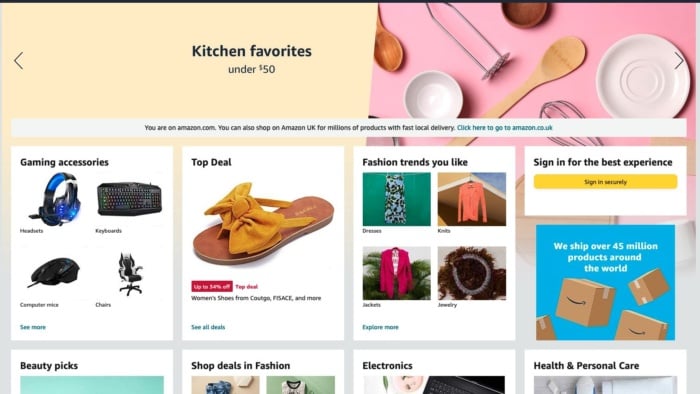 SEO
SEOSEO stands for search engine optimization. Itís the process of optimizing your website to increase the chances it appears on the first page of Google (and other search engines) for relevant terms.
Given that 68 percent of online experiences begin with a search engine, SEO is a fantastic way to reach a massive B2C audience in a cost-effective manner. Thanks to platforms like Google Analytics, B2C marketing attribution is also easy with SEO.
Given that SEO can have an incredibly high ROI (the ROI in the e-commerce sector has been found to be 317 percent), SEO is a fantastic way to reach a massive B2C audience in a cost-effective manner.
B2C athleisure wear brand Gymshark is a great example of how powerful SEO can be. They rank for over 145,000 keywords and generate over 2 million organic visitors.
 Email
EmailEmail is a huge marketing channel in the B2C space. Think how many emails you get every week from brands. Itís probably a lot given there are 347.3 billion emails sent every day. Thereís a reason that number is so high; itís because they are easy and cheap to sendóand they can generate a huge ROI.
Hereís a great example of a B2C abandon cart email from Lego encouraging users to go back and make a purchase:
 Social Media
Social MediaSocial media is a more popular marketing channel for B2C brands than B2B companies. Research from HubSpot shows that B2C marketers use every social media platform more than their B2B counterparts except LinkedIn.
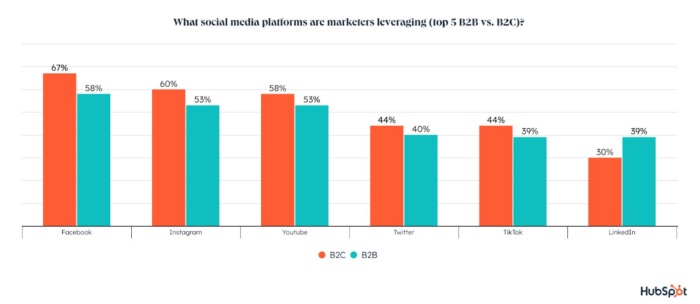
Whether itís Facebook and Instagram or Twitter and TikTok, almost every B2C brand will find its audience somewhere on these platforms.
You donít even have to sell online to make a splash on social media. Fast food chain Wendyís uses social media to build huge brand awareness and increase customer loyalty.
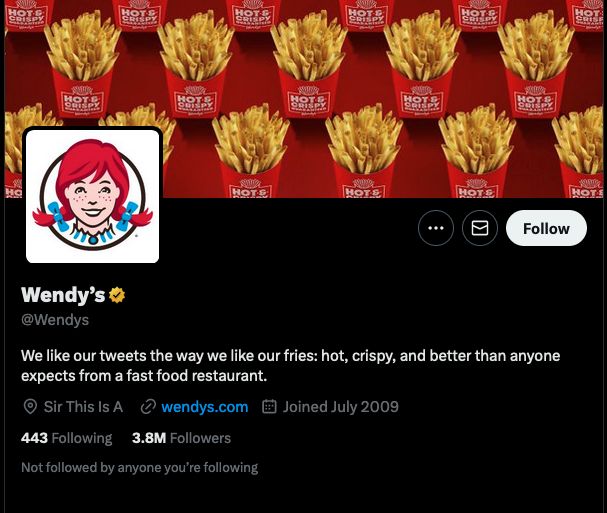 SMS
SMSSMS (or text messaging) marketing lets your brand slide into your potential customersí messages. Given that over three quarters of consumers use their phone to make a purchase, then reaching them directly on these devices can be powerful.
Hereís a fantastic example of how you can promote your products by text, courtesy of Crocs.
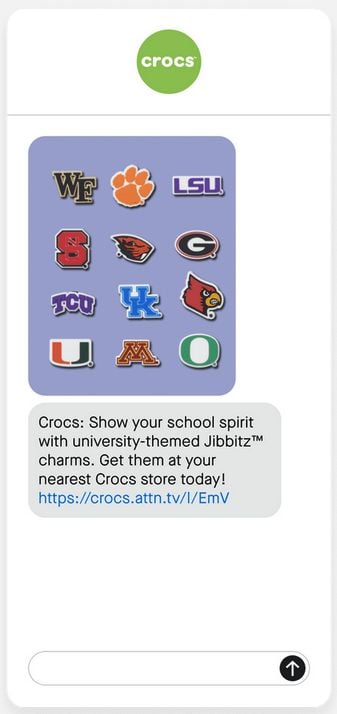 Paid Search
Paid SearchGiven that over two-thirds of web experiences start with a search engine, itís no wonder brands pay to feature at the very top of the results. It can be expensive depending on your industry (like insurance, for example) but you only have to pay the search engine when someone clicks. And like SEO, B2C marketing attribution is easy.
DisplayDisplay ads is a broad B2C digital marketing channel that includes any form of text, image, or video ad that appears on a website. These are incredibly common on magazine-style web publishing sites that use platforms like the Google Display Network to generate revenue.
Googleís Display Network is one of the largest ad networks, featuring more than two million sites and reaching over 90 percent of internet users.
The sheer reach of these networks makes display ads great for brand awareness. But they can generate impressive ROI, too. Research by Google found that when advertisers used Display Network ads alongside search ads, the median CPA of Display Network ads was within 2 percent of their search CPA.
Checkout this example from Polestar:
 YouTube
YouTubeThere are two ways you can use YouTube as a B2C marketing channel. One is through ads, the other is through a branded channel.
Most consumers dislike YouTube ads, but that doesnít mean they arenít an effective B2C marketing channel. After all, you have a captive audience in many cases. Just make sure you can get your message across as quickly as possible.
You donít have to run ads to make a splash on YouTube, however. Brands like GoPro use branded channels to promote their content marketing efforts.
 Television and Streaming Ads
Television and Streaming AdsIf you have a bigger budget, then TV and streaming ads may be an effective marketing B2C channel. These can be very, very expensiveóboth in terms of the placement and the cost of production. A 30-second ad during Sunday Night Football can cost $828,501 for the placement alone.
They can be well worth it, however. After all, everyone remembers classic TV ads, like this one from Apple:
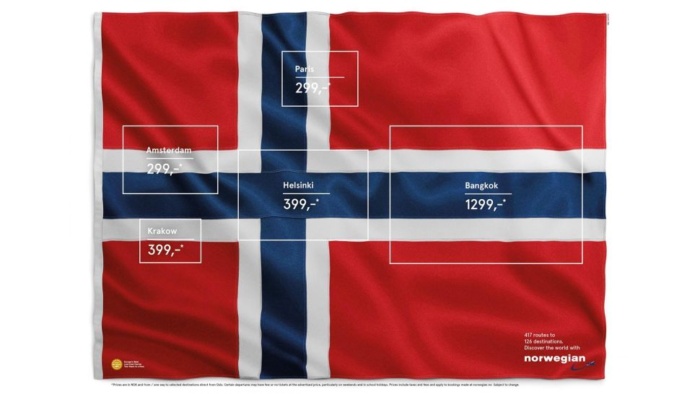 B2C Marketing Strategies to Attract and Engage Customers
B2C Marketing Strategies to Attract and Engage CustomersThereís no shortage of B2C marketing strategies you can use to attract buyers. Below I cover some of the most popular and powerful methods.
1. Create Engaging ContentContent marketing is one of the most powerful marketing strategies for B2B businesses. But I find itís regularly overlooked by B2C brands. Thatís a shame because B2C content marketing can be incredibly effective.
The more content you create, the more opportunities you have to educate and engage your target audience. You donít have to limit yourself to blog posts, either. Menís grooming brand Beardbrand built an audience through YouTube videos.
Print AdvertisementsA more cost-effective way of getting your B2C brand in front of a large offline audience is print advertisement. Whether itís direct mail or an ad in your local paper, print can help you get almost any message across.
This creative ad by Norwegian Airlines is a great example of how much you can get across in a single ad:
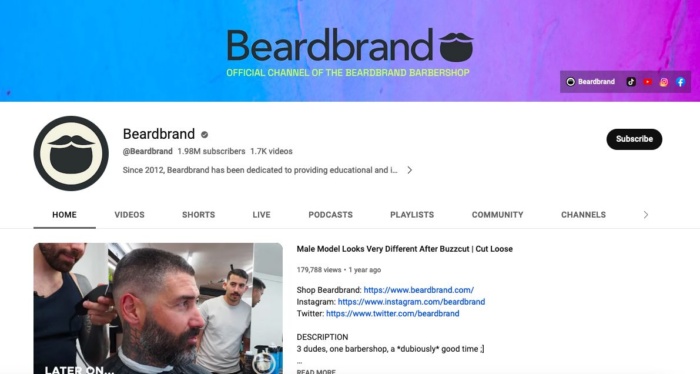
You donít have to always create content yourself, either. User-generated content (UGC) is content created by your audience members. This can be reviews, messages on a forum, or even social media content from customers that you share with your audience (with permission).
2. Use Social Media to Connect with Your AudienceConsumers spend an average of 151 minutes per day on social media. Thatís time you could be connecting with them. That doesnít mean you have to constantly promote your products, however. You can use social media to showcase your brandís personality (like Wendyís do above) or use it as a customer support channel.

Some brands like Crypto.com even have dedicated accounts for customer support.
3. Lean Into Influencers
Love them or hate them, influencers are a big deal in the B2C marketing space. You donít need to blow your budget on someone like Bella Hadid to see success, however.
Micro-influencers (people with less than 100,000 followers) are a much more cost-effective method of increasing brand awareness and sales. If you want to learn more, this article will teach you how to build a team of social media influencers.
4. Optimize Your Content for SEORegardless of whether you are running a content marketing campaign or not, you should optimize your website for SEO.
Youíll want to use a combination of on-page and off-page strategies. First, make sure all of your websiteís sales pages (that includes e-commerce product and category pages) are optimized for relevant keywords. Include them in the pageís title, URL, headings and copy.
Then run a link-building campaign to increase your websiteís authority. The more high-quality backlinks your site has, the higher it should rank in Google.
5. Run Retargeting CampaignsNot every consumer who lands on your website is going to make a purchase immediately. The B2C sales cycle may be short, but itís not that short. But you can use a retargeting campaign to advertise to those consumers until they do.
When you launch a retargeting campaign, you show relevant ads on websites and social media platforms to users who have visited your site but who didnít convert.
6. Offer Rewards and Exclusive DiscountsIf thereís one strategy I know that almost always works itís giving your customers exclusive rewards and discounts. Not only do customers love getting something for free, but they also love feeling like they are part of a special club.
Beauty Insider Benefits from Sephora is a great example of a rewards program. Members earn 1 point for every $1 they spend as well as additional savings like 10 percent off seasonal events and free shipping. Customers can even pay to access more benefits.
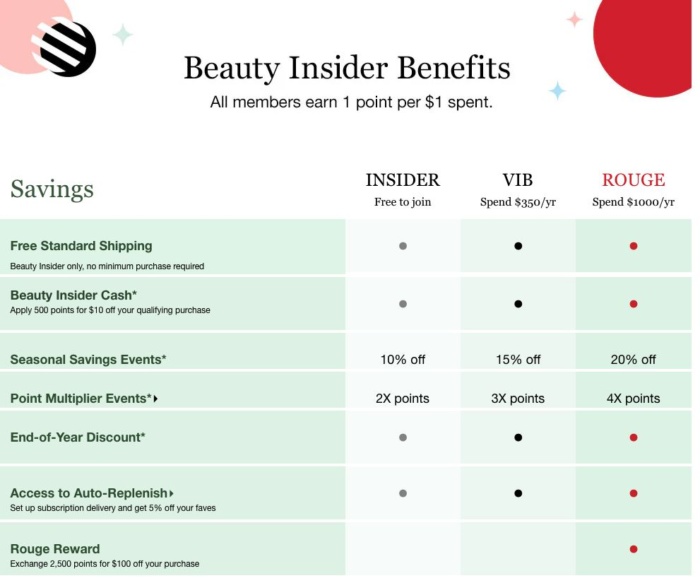
The best thing about rewards and discounts is that they donít have to cost your brand anything. Sure youíre giving a small bit away, but you should more than make up for it through an increase in sales.
7. Use Email to Nurture Leads and Build LoyaltyIf youíre not already collecting emails from your customers and website visitors, start right now. If you are, make sure you have set up a series of email campaigns.
There are loads of strategies you can use to nurture prospective customers in your B2C marketing funnel, build loyalty, and increase sales. You can set up an abandoned cart email sequence, for example, create a regular newsletter, or send an email every time you write a new blog post.
8. Consider Starting a PodcastIf you really want to stand out and take your content marketing to the next level, then consider starting a podcast. There are plenty of examples of B2C brands doing this effectively. Check out Duolingo, Bobbie Bobbie Baby Formula, and Thrive Market.
9. Emphasize Your Commitment to Social ResponsibilityItís not enough to sell great products. Consumers also care about what brands stand for and how they behave. Itís why brands like Patagonia have become so popular.
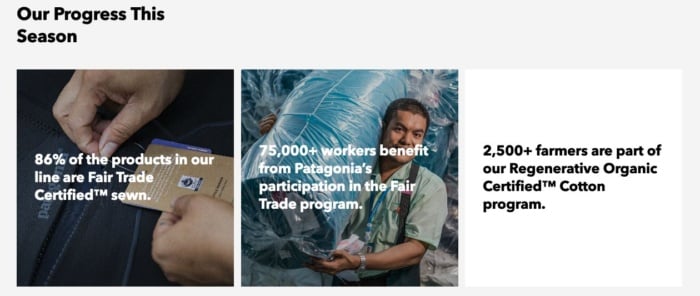
This is particularly important if you target younger generations. Almost two-thirds of Gen Zís aged 14-17 and 62% aged 18-26 say they want to collaborate with brands to address key social issues. Sixty-three percent believe a brandís actions should reflect what they stand for.
Measuring the Success of Your B2C CampaignsHow you measure the success of your B2C marketing campaigns will depend largely on your goals. Youíll want to make sure the key performance indicators (KPIs) you track are as relevant as possible. So if you want to increase website traffic from SEO, for example, youíll want to track SERP rankings, SERP click through rates, and web traffic from Google.
Here are some common B2C marketing KPIs to get you started:
Web traffic: If you want to drive customers to your website, this KPI is key. Donít forget to split it into channels to see which B2C marketing channel is driving the most traffic.
Conversion rate: Traffic isnít any good if it doesnít convert. Thatís why you need to measure your siteís conversion rate. You can also measure the conversion rate of specific B2C marketing strategies like PPC ads.
Social engagement: Social media is a vital part of the B2C marketing mix. Forget about vanity metrics such as Likes and Views. Measure engagement instead.
Customer retention rate: You donít just want to win customers; you want to retain them. Thatís why I always recommend B2C brands measure their retention rates.
Customer satisfaction score: One of the most accurate forecasters of customer retention rate is your customer satisfaction score. NPS is my favorite metric to measure this.
B2C Marketing ToolsB2C marketing becomes a lot easier when you have access to the right tools. Here are some solutions I think will greatly help your efforts.
SEO and PPC marketing tools: Tools like Ubersuggest and Semrush are virtually mandatory to improve your SEO and PPC efforts.
Market research tools: The more you can learn about your market the easier youíll find it to create messages that cut through the noise. I turn to Answer the Public for help here.
B2C marketplaces: You donít have to sell directly to consumers from your website or storefront. B2C marketplaces like Amazon and Etsy mean you donít have to invest thousands into acquiring customers.
Analytics platforms: You need to know how customers behave on your website. Thereís no better tool than Google Analytics.
Email marketing tools: These platforms can be one of the most cost-effective ways to reach your target audience. Try Mailchimp or MailerLite to start.
Overcoming Challenges in B2C MarketingMarketing a B2C business isnít plain sailing. Youíll need to overcome the following challenges:
Rising Competition and SaturationUnless you operate in a relatively niche industry or have a product so revolutionary that youíve created your own market, you probably face stiff marketing competition from other brands. Thatís the trouble with B2C marketing; thereís way more companies trying to compete for the same eyeballs.
One way to beat the competition is to have a superior product. Another is to have a superior marketing strategy. You can outwork the competition by optimizing your ad campaigns to the nth degree or building the perfect SEO strategy. Or you can do something no one else is doing, like launch a controversial campaign or invest in a PR stunt.
Data Privacy and Security ConcernsPrivacy and security are major concerns in the B2C environment. Customers care about their data more than ever, with almost three-quarters ranking data privacy as one of their top values.
When you are capturing and storing data from customers you need to make sure you are doing so in a compliant manner. That means abiding by GDPR if you operate in the EU and the California Consumer Privacy Act if you operate in the U.S.
If youíre concerned about privacy issues, I recommend keeping your efforts limited to first-party data. Seventy-one percent of companies expect brands to offer personalized interactions, so you canít afford to reject data collection entirely. But you can ensure you only use the customer data you collect to provide those experiences.
Adapting to Changing Consumer Trends and PreferencesIn the B2C world, consumer trends and preferences can change in an instant. Whatís hot one minute, may soon be out of favor the next. Certain causes can be championed vehemently, then forgotten about a week later. As a B2C brand, you need to roll with the punches and stay on top of rapidly changing consumer sentiment.
In some cases, this will mean tweaking your messaging, imagery, and other marketing collateral. In other cases, it will mean creating new consumer products that you can market in case the popularity of your main product fades.
FAQsWhat does B2C mean in marketing?B2C, or business-to-consumer, in a marketing context refers to the strategies that consumer-facing brands use to attract and nurture customers. This typically involves a lot of online marketing, including PPC, SEO, and social media. But it can also include television and other traditional advertising formats.
What is B2C? B2C, or business-to-consumer, is a type of business where an organization sells products or services directly to individual customers rather than other businesses. Some of the most well-known companies in the world are B2C, including Nike, Starbucks, and Amazon.
What is B2B and B2C?B2B and B2C are two different forms of marketing. B2B refers to business-to-business marketing and B2C stands for business-to-consumer marketing.
ConclusionB2C marketing is one of the most important strategies any consumer-facing brand can use to grow its business. As youíll now realize, thereís no single B2C marketing strategy or channel that will work for everyone.
Thatís why I advise you to try one or two channels and a couple of different marketing strategies first. Only once youíve got a firm grasp of who your audience is and how they behave, should you start to tailor your efforts and start experimenting with new channels.
Source: NP Digital, LLC
Original Content: https://neilpatel.com/blog/b2c-marketing-guide/